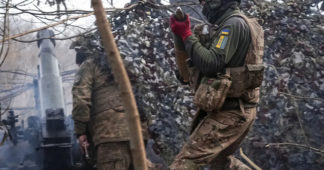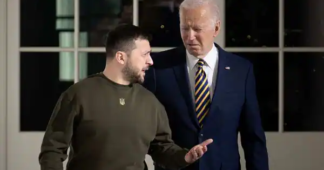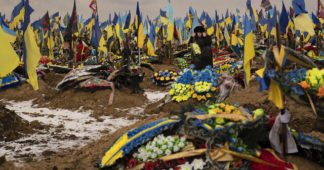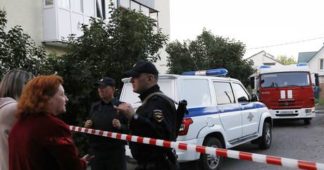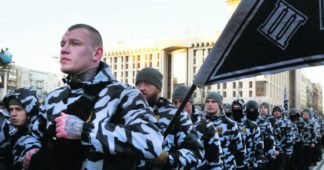By Dmitri Kovalevich
27 May 2024
Shortly after the inauguration of Russian president Vladimir Putin on May 7 for another seven-year term, the Russian armed forces opened a new front in Kharkiv oblast (province) in Ukraine’s northeast along the pre-war Russian border. A number of small settlements have been captured; the latest to fall is the town of Vovchansk (pre-war population of 17,000), some 70 km north and east of Kharkiv city. Ukrainian troops were unprepared for this turn of events, while the number of Russian troops involved was rather small, at 2,000 to 4,000.
Kiev regime unable to build defensive fortifications
The new Russian forays demonstrate once again the high level of corruption prevailing in Ukraine, particularly as regards the construction of defensive lines on which its army units rely when needed. Ukraine regime president Volodymyr Zelensky told the country one month ago that defensive lines were ready in the Kharkiv region, but in fact, they hardly exist. Some of the engineering structures destined for these lines—the so-called ‘dragon’s teeth’ anti-tank fortifications–were indeed delivered back in 2023 but were simply piled in a heap.
‘Where are the fortifications?’ screams a May 13 headline in Ukrayinska Pravda. The sub-headline reads: ‘The regional military administration of Kharkiv paid millions to fictitious companies’. According to the report, “Hundreds of millions of hryvnias (100 million hryvnia equals US$2.5 million) were probably stolen during the construction of fortifications in the Kharkiv region where the Russian Armed Forces are now actively advancing.” The article explains that directors of several companies hired to build the fortifications have past criminal convictions or are facing new ones and that several ‘winners’ of government contracts for such work were not even informed of their good fortune.
The Ukrainian military has abandoned numerous positions during the recent Russian forays and is citing the corruption they have witnessed as an explanation. Ukrainian serviceman Denis Yaroslavsky told the UNIAN news agency on May 13, “The first line of fortifications and mines simply did not exist… In two years, there should have been concrete fortifications three stories deep along the Ukrainian border! But there are not even mines. We conclude that this is either insane theft or willful sabotage.”
The Sputnik Russian news agency reported way back in 2016 on the fate of the ‘European Wall’ to separate Ukraine from Russia which was touted by leaders of the February 2014 coup in Ukraine. It read, “One of Ukraine’s most widely discussed and costly projects from the times of the former Prime Minister Yatsenyuk – a giant wall on the border with Russia dubbed no less than ‘The European Rampart’ turns out to be a figment of our collective imagination.” The report explained that back then, billions of hryvnia were earmarked for this project but almost nothing was built.
In 2023 and 2024, respectively, Ukrainian troops faced the same problem of poor or non-existent defensive fortifications during Russian offensives to take cities of Artyomovsk (called ‘Bakhmut’ in Ukraine) in 2023 and Avdeevka in early 2024, both located in what is now the Donetsk Republic of the Russian Federation(Donbass region). The defensive positions to which Ukrainian troops were ordered to withdraw in both occasions were ‘fortified’ only on paper. In reality, the fortifications were just a chaotic set of shallow pits.
“It’s the world’s fault,” Zelensky told a reporter for ABC News (U.S.) on May 16. “They gave the opportunity for Putin to occupy [Ukraine territory], but now the world can help.” The ABC report explained, “The situation in Ukraine is so serious that President Volodymyr Zelenskyy has canceled a planned trip to Spain and come straight to Kharkiv, the country’s second-largest city. The city is in real danger from Russian advances.”
Ukrainian intelligence is reporting that the Russian army is also preparing to invade the adjacent, northern border oblast of Sumy. The capital cities of Sumy and Kharkiv are app. 120 km apart. As it turns out, the fortifications protecting Sumy are also fictitious, although large sums have been spent on them. Strana.ua writes on Telegram, “In the Sumy region, the ‘dragon’s teeth’ intended for the construction of defensive lines have been dumped on the side of roads. This is reported by the Black Box Face Club community on Instagram along with relevant photos. Previously, a similar photo was published in the Kharkiv region, where the Russians are now advancing.”
Ukraine’s chronic inability to build fortifications is partly a consequence of its inability to implement any major construction or infrastructure project since it seceded from the Soviet Union in 1990/1991. Funding for such projects has simply been wasted or stolen.
Western governments and financial institutions have long tried to impose a neoliberal, capitalist economic model on Ukraine, in place of its former planned and state-owned economy. The Western model assumes that the construction of defense facilities would be handled by private businesses. A tender is announced and the company that offers the best price and conditions wins the bid. In practice, however, it is the companies associated with government officials that usually win, while others are simply blocked from participating. Often, a ‘winning’ company has neither equipment nor employees but is a fictitious company registered somewhere in the Virgin Islands or Cyprus. Funds are transferred to the company, no work is done, the company is liquidated, and an ‘investigation’ is then launched that can drag on for years.
In Russia, fortifications are built by engineering troops specifically dedicated to such work. There are no such equivalents in the Ukraine Armed Forces (AFU). These receive all construction materials free of charge from the factories of the Ministry of Defense. These factories do not buy from private businesses all the components necessary for this purpose; these are supplied by state defense enterprises, right down to free food for employees which is produced on large farms operated by the Ministry of Defense.
Of course, there is also corruption in the Russian military; periodically, Russian generals end up in jail. But unlike the Western model of a military-industrial complex, there are no private middlemen in Russia inflating prices several times over and only interested in making a quick profit and sending the money to bank accounts abroad.
Multiple-bite tactics
Strana.ua reported on May 17: “The situation with the Russian offensive in the Kharkiv region, which began exactly one week ago, is unfolding almost identically to the recent Russian breakthroughs in Avdeevka in February 2024 and around Ocheretino and Chasov Yar most recently. The Russians find a weak spot in the defense, strike there, and advance relatively quickly by the standards of the current war at a few kilometers per day. After that, the AFU throws reserves to the places of breakthrough to slow down or stop the advance.”
According to Strana journalists, the Russian army has enough strength to break through the Ukrainian front here and there and take the initiative. Even without a ‘general offensive’, such advances by “a thousand small cuts” drains the resources of the Ukrainian army and are very dangerous for it.
Simply put, the Russian Armed Forces are playing with the AFU, imposing a battle in one place or another, forcing the AFU to constantly move their depleted reserves. The Russian forces have already entered Kharkiv and Sumy regions, in 2022. They left without a fight, judging potential losses and physical damage to be too high. Now they are approaching again; some Russian analysts believe they may yet withdraw again.
The Ukrainian media noticed in 2022, a few days before Russia launched its military intervention into Ukraine, that the unofficial name of the ‘Special Military Operation’, as it was called by Russia initially, was ‘Mongoose Throw’. The name was interpreted as being drawn from the behavior of a mongoose when fighting poisonous snakes – it uses deceptive maneuvers and sharp jumps side-to-side to wear down the snake, then delivers a final blow.
Comparison of tactics through the eyes of a Ukrainian military officer
In mid-May, an interview in the Zerkalo Nedeli weekly with a Ukrainian military officer using the call sign ‘Ronin’ made a lot of noise in Ukraine because it differed sharply from the official assurances by the AFU command that the overall military situation is “under control”. The writer claimed that the military front could soon collapse if there is no significant reinforcements. “We will simply have no one to fight with,” he said. “Yes, there are weapons in our battalion, but there is no one to fire them.”
The Ukraine government has pleaded that it has no money for the war unless and until the U.S. Congress provides a new round of funding. Now it turns out there are fewer and fewer soldiers to use the weaponry, despite the ongoing, forced conscription of men (called ‘kidnappings’ by increasing numbers of Ukrainians).
In the interview, ‘Ronin’ also criticized the quality of previous waves of military recruits, saying that many consisted of alcoholics and others unfit for service as well as people from the impoverished countryside without the money to bribe their way out. Because of Ukraine’s need to quickly replenish military units, the training period has been reduced from three months to one month. He calls the recruitment process “a conveyor belt without military skills being learned”. He contrasts the training of Ukrainian soldiers to that of Russian soldiers. The latter train for six months; their training even includes practice at assaulting fortified areas.
He also criticizes the NATO standards used for training, which he says are detached from the realities of the Ukrainian conflict. “What are ‘NATO standards’? It is like going to a doctor or medic to have a wound treated and they recommend an air evacuation. You explain ‘But there is no air evacuation available.’ Then follows silence.”
“Many of those who have been fighting for a long time and still want to survive in this war react very simply to various kinds of threatening orders by officers: they agree to the order, and then they sit in their dugouts, realizing that the chances of staying alive from such an order are very slim. I can understand them because many orders are downright insane, drawn from crosses and arrows on a map without considering the safety of those who would carry them out.”
‘Ronin’ says many soldiers run away from their units, especially if they are transferred to assault units. Deserters who go AWOL are usually not punished because of their high numbers. If they were all punished, there would be no one left to fight. He adds that financial bonuses available to soldiers for this or that act no longer work as incentives for Ukrainian servicemen, saying money is no good to someone who has lost their life or been crippled for life.
Contrasting the situations of the AFU and the Russian army, Ronin says that Russia’s army is steadily growing and developing, and working on their mistakes. This goes against the propaganda messaging by the Ukrainian government and military. “The other side of this war are not idiots, they are learning. Why have the [U.S.-supplied] Himar and [French-supplied] Excalibur missiles stopped working for us properly? Because Russia has learned to pinpoint their geolocation and shoot them down. They have developed their Lancets [assault drones] which cost a pittance but kill tanks and even kill the [U.S.-supplied] Paladin [self-propelled howitzer], a very costly armament.”
The most dangerous thing for the AFU, according to the Ukrainian military officer, is that the Russians are fighting systemically. “Their paratroopers have already realized what not to do as they are trying to take care of their men. Their technique is as follows. They try to hit the entire front, and when they see a weak spot, they start hitting there with all their forces. They know very well how to dig in quickly. As soon as they become engaged, they dig in. They may lose people, but it is very difficult to force them out of there.”
In Ukraine, ‘Ronin’ says, the government and military are guilty of confusing the ‘reality’ as presented by media with reality itself. “The media president has become the president of the country, but he continues to live a media reality,” the Ukrainian military officer says in reference to Zelensky, who was a television star before entering politics in the 2019 presidential election.
Kidnappings on Blinken’s orders
Against the background of the failures near Kharkiv, United States Secretary of State Anthony Blinken urgently came to Kyiv on May 14 and issued a call for more Ukrainians to be conscripted. Forcible conscriptions in Ukraine have taken on the character of daily kidnappings from homes, streets, and workplaces, accompanied by beatings of those who resist being taken. Along Ukraine’s border, police and border guards have begun shooting Ukrainians fleeing the country. On May 15, a man trying to cross into Romania ignored ‘warning shots’; one of them happened to strike him in the head and kill him.
The Western media has long talked about the totalitarian regime of the former East Germany [German Democratic Republic] which prevented Germans from leaving the country by building a wall. Ukraine’s ‘wall’, or the idea of one, is treated much differently today, very favorably.
Viktor Andrusiv, a former adviser to the head of the Interior Ministry of Ukraine, calls fugitives from Ukraine “gypsies”, using an old Nazi term and tradition of arousing racist animosity. “If you are an evader [conscription evader], you deliberately ran away. So you have no right to say that you are Ukrainian; you are a Gypsy. You chose the Gypsy life. Some believe that evaders who fled abroad are ‘happy’. Happy about what? Living in some shipping container for the rest of their lives? Working only in black market jobs because they don’t know the language or their qualifications are not recognized? These are people who in the course of saving their lives have condemned themselves to dishonor.”
Failure of the strategy to pressure the Global South
Blinken’s unexpected visit to Ukraine on May 14 was linked to preparations for a so-called ‘peace summit’ to take place in Switzerland in June. Zelensky is trying to get as many countries as possible from the Global South to attend. He told media on the day of Blinken’s visit, “We discussed preparations for the Global Peace Summit. It is important to us that the United States, President Biden, participate, and that America’s role in maintaining a rules-based global order does not weaken.”
Unfortunately for Zelensky, for his government, and for his Western backers, countries are declining to participate, including China, Brazil, and South Africa. They have said from the beginning that Ukraine should negotiate with Russia if it wants a peace agreement. They say there is no point in holding an international conference to which the Russian Federation is not even invited. Ukrainian media is reporting that of 160 countries invited to Switzerland, only 50 have so far accepted to participate, and almost of these are wealthy Western countries. Russia says even the location is flawed because it no longer considers Switzerland to be a neutral party to the conflict.
A ‘peace summit’ has special importance for Zelensky because his election term as president expires on May 20. Such a summit with him in official attendance would legitimize his continued but now unelected rule.
Ukraine’s rulers are looking backward to the future, staking the country’s future on a subordinate economic, political, and military association with the European Union and the NATO military alliance. But that collection of countries and their ‘rules-based international order’ is in decline, offering nothing more than war and second-class economic status to countries such as Ukraine that are not already members of the select club of imperialist countries.
The outlook held by Russians is quite different. The people of the Russian Federation now consider the Western countries to offer nothing to them—economically, culturally, and spiritually. An example of where Russians are looking for ideas for the future was recently offered by Sergei Naryshkin, director of the Foreign Intelligence Service of Russia and chairman of the Russian Historical Society. He spoke to an academic conference in Moscow in May and said, “Today when Russia is at the forefront of a global change in the world order, very useful applied lessons can be drawn from the experience of the Communist International.”
He said the ideas of the ‘Comintern’ have not stood the test of time, but they were not destructive in their time. In its own way, he says, the Comintern program was “progressive and creative”. He says the popularity of the Communist International was greatly due to its opposition to fascism and Nazism, explaining how in 1923, the organization’s leadership created the World Committee for the Struggle against Fascism, and how the seventh (and last) congress of the ‘Comintern’ in 1935 declared that “an irreconcilable fight against fascism was the task of all left forces.”
In addition, the Comintern experience helped to inspire the anti-colonial and anti-imperialist struggles in Asia that saw China, Korea, and Vietnam win their independence and embark on socialist revolutions.
The conference in Moscow took place in the former headquarters of the Executive Committee of the Communist International in the city. Today, the building is part of the Russian State Social University in Moscow. Sergei Naryshkin is a permanent member of Russia’s Security Council and served as speaker of the State Duma (legislature) from 2011 to 2016.
We remind our readers that publication of articles on our site does not mean that we agree with what is written. Our policy is to publish anything which we consider of interest, so as to assist our readers in forming their opinions. Sometimes we even publish articles with which we totally disagree, since we believe it is important for our readers to be informed on as wide a spectrum of views as possible.
